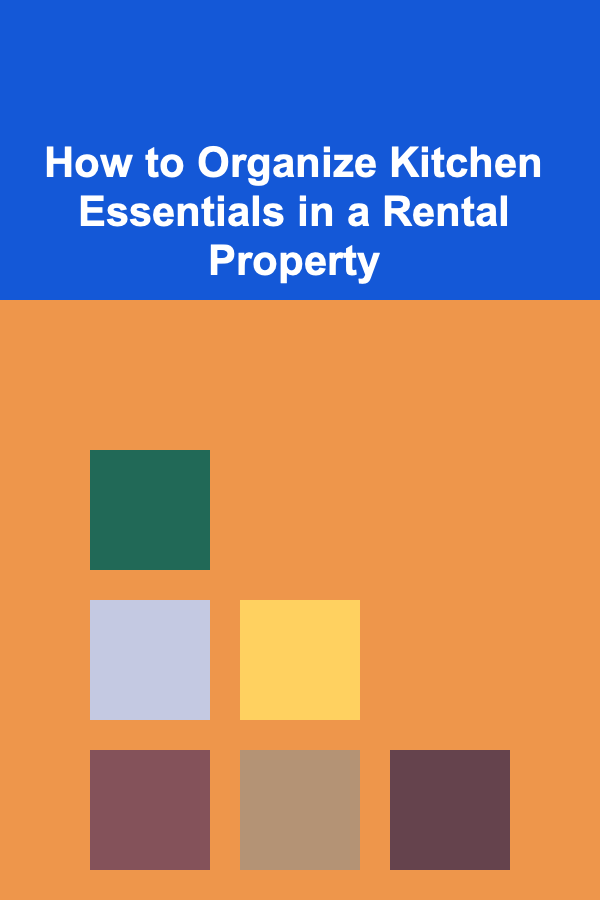
How to Budget for Homeownership When You're Self-Employed
ebook include PDF & Audio bundle (Micro Guide)
$12.99$8.99
Limited Time Offer! Order within the next:

Owning a home is a significant milestone for many people, but the path to homeownership can be more complex for those who are self-employed. Unlike traditional employees, self-employed individuals do not receive a regular paycheck, which can make it harder for lenders to assess their income stability and financial health. However, with careful planning, strategic budgeting, and the right approach, self-employed individuals can successfully navigate the process of purchasing and maintaining a home.
In this comprehensive guide, we will explore how to budget for homeownership when you're self-employed. We'll cover everything from understanding your finances and creating a savings plan to securing financing and managing homeownership expenses. Whether you're a freelancer, a business owner, or an independent contractor, this article will help you lay the foundation for financial success in your journey to homeownership.
Understanding the Unique Challenges of Homeownership as a Self-Employed Individual
1.1. The Income Uncertainty of Self-Employment
The most significant challenge for self-employed individuals when it comes to homeownership is the unpredictability of income. Unlike salaried employees who have a consistent paycheck, self-employed people often deal with fluctuating income. Your earnings might vary greatly month-to-month, especially in industries where seasonal fluctuations or project-based work are common.
This income volatility can make it difficult for lenders to gauge your ability to repay a mortgage, as they typically look for a stable, predictable income stream. As a result, you may face stricter scrutiny when applying for a mortgage loan, and you may need to provide additional documentation to demonstrate your financial stability.
1.2. The Difficulty of Securing a Mortgage
Self-employed individuals often face more challenges in securing a mortgage due to the perceived risk associated with nontraditional employment. Lenders typically prefer borrowers with stable, long-term employment and reliable income. As a self-employed person, you'll need to prove your ability to make timely mortgage payments, which may require more extensive documentation than salaried borrowers.
For example, traditional lenders usually request pay stubs, W-2 forms, or tax returns to verify income. As a self-employed individual, you may need to provide multiple years' worth of tax returns, bank statements, profit-and-loss statements, and other financial records to demonstrate your ability to maintain a steady income.
1.3. Higher Interest Rates and Larger Down Payments
Another challenge of homeownership for self-employed individuals is the possibility of higher interest rates and larger down payments. Because of the perceived risk associated with self-employed borrowers, lenders may offer less favorable loan terms. You may be required to put down a larger down payment (e.g., 20% or more) to offset this risk, and your interest rates could be higher than those offered to salaried borrowers.
1.4. The Need for Thorough Financial Planning
Self-employed individuals need to be particularly diligent when budgeting for homeownership. Since your income can vary, it's essential to have a clear understanding of your finances and to plan accordingly. Without a regular paycheck, you must build financial buffers to account for any income fluctuations. Additionally, managing your business expenses and ensuring personal and business finances are properly separated will be key to maintaining a stable financial position.
Building a Solid Foundation for Homeownership
2.1. Get Your Finances in Order
Before you start thinking about homeownership, it's important to take stock of your finances and get your financial house in order. Start by calculating your total income, expenses, and debts. Knowing where you stand financially will give you a clearer picture of your ability to afford a mortgage and the monthly payments involved.
Tips for Getting Your Finances Ready:
- Track your income: Document your income streams from your self-employed business. If you have multiple clients or projects, create a detailed record of all income sources and amounts received.
- Create a budget: Develop a budget that accounts for your personal and business expenses. Ensure that you're setting aside money for savings, investments, taxes, and any other financial obligations.
- Pay down debt: Focus on paying down any outstanding debt, particularly high-interest credit card balances. Reducing your debt-to-income ratio will make you a more attractive borrower to lenders.
- Build your emergency fund: Having an emergency fund is especially important for self-employed individuals, as it provides a financial cushion during lean months. Aim to save three to six months' worth of living expenses.
2.2. Separate Personal and Business Finances
It's essential to keep your personal and business finances separate, both for organizational purposes and for your tax filings. Maintaining separate bank accounts for your personal and business expenses will give you a clearer picture of your personal income and expenses. Additionally, lenders will look at your business income when assessing your ability to repay a mortgage, so keeping clear records is essential.
To help with this separation, you can consider hiring an accountant or using financial software to track and categorize your expenses and income. This will help ensure that you're always ready for tax season and that your financial documents are in order when applying for a mortgage.
2.3. Calculate How Much You Can Afford
Once your finances are in order, the next step is determining how much home you can afford. This involves assessing your income, monthly expenses, and debts. When considering how much house you can afford, lenders typically look at two primary ratios:
- The front-end ratio: This is the percentage of your monthly income that goes toward housing expenses, including the mortgage payment, property taxes, and insurance. Most lenders prefer this ratio to be no more than 28% to 31% of your gross monthly income.
- The back-end ratio: This ratio includes all of your monthly debt obligations (including your mortgage payment, car loans, student loans, and credit card payments). Lenders generally prefer this ratio to be no more than 36% to 43% of your gross monthly income.
To calculate these ratios, use your monthly income and current debt obligations to determine the maximum mortgage payment you can afford. Online mortgage calculators can help you figure out what your monthly payment might be based on different loan amounts and interest rates.
2.4. Save for a Down Payment
A significant portion of your homeownership budget will be the down payment. Traditionally, homebuyers are encouraged to put down 20% of the home's purchase price to avoid private mortgage insurance (PMI). However, there are loan programs that allow for lower down payments, such as FHA loans (which can require as little as 3.5% down).
Because you may be required to put down a larger down payment as a self-employed borrower, it's important to start saving early. Set aside money each month to build your down payment fund, and consider cutting back on unnecessary expenses to accelerate your savings.
2.5. Consider the Costs of Homeownership Beyond the Mortgage
When budgeting for homeownership, it's important to remember that the mortgage payment is just one part of the equation. Homeownership comes with additional costs that you'll need to account for in your budget:
- Property taxes: Property taxes can vary widely depending on the location and value of your home. Be sure to research property taxes in your area and factor this into your monthly budget.
- Homeowner's insurance: Homeowner's insurance is a necessity to protect your property from damage or loss. Shop around for the best coverage and rates.
- Maintenance and repairs: Owning a home comes with ongoing maintenance costs, such as repairs, upkeep of landscaping, and cleaning. Plan for these expenses by setting aside money each month for home maintenance.
- Utilities: Your utility bills, including electricity, water, and gas, will be a regular part of your budget. Consider using energy-efficient appliances and technologies to help reduce utility costs.
Securing Financing for a Home
Once you've assessed your finances and are ready to purchase a home, it's time to secure financing. As a self-employed individual, securing a mortgage can be more challenging, but it's not impossible.
3.1. Gather the Necessary Documentation
Lenders will need to see a range of documents to assess your income, financial stability, and ability to repay a mortgage. As a self-employed individual, you may need to provide:
- Tax returns: Lenders will usually require two to three years of tax returns to verify your income. Be sure to have these documents ready.
- Profit and loss statement: If you don't have consistent income or if your business is relatively new, a profit and loss statement can help demonstrate your business's financial health.
- Bank statements: Lenders may ask for several months' worth of personal and business bank statements to confirm your financial stability.
- Credit history: Just like salaried borrowers, your credit score will play a significant role in determining your mortgage eligibility. Maintain a healthy credit score by paying down debt and making payments on time.
3.2. Shop Around for Mortgage Lenders
Not all mortgage lenders have the same requirements or offer the same terms. It's important to shop around and compare mortgage products to find the best deal for your financial situation. Consider working with lenders who have experience working with self-employed individuals and are familiar with the documentation you'll need to provide.
3.3. Consider Non-Traditional Lenders
If traditional mortgage lenders are unwilling to work with you, consider non-traditional lending options. Online mortgage lenders, credit unions, and other financial institutions may be more flexible with their requirements and could offer better terms for self-employed individuals.
Managing Homeownership Expenses
Once you've secured a mortgage and become a homeowner, it's essential to manage your finances wisely to ensure long-term success. Budgeting and maintaining a stable income will help you avoid financial strain and ensure that you're prepared for unexpected expenses.
4.1. Maintain a Cushion for Emergencies
Self-employed individuals are more vulnerable to fluctuations in income, so it's critical to maintain a financial cushion to cover any unforeseen circumstances. Set aside money in an emergency fund specifically for home-related expenses, such as repairs, renovations, or unforeseen circumstances like job loss or illness.
4.2. Track Your Monthly Expenses
Keeping a close eye on your expenses will help you avoid financial surprises and ensure that you have enough money to cover your mortgage payments, utilities, and other homeownership costs. Regularly track your income and expenses using a budgeting app or software.
Conclusion
While budgeting for homeownership as a self-employed individual may present unique challenges, it is certainly possible with the right strategies in place. By understanding your finances, saving for a down payment, securing appropriate financing, and managing homeownership costs, you can achieve your dream of owning a home. With careful planning and discipline, you can successfully navigate the road to homeownership and enjoy the stability and security that comes with owning a home.
Reading More From Our Other Websites
- [Personal Finance Management 101] How to Optimize Your Credit Score for Better Financial Opportunities
- [Home Soundproofing 101] How to Build a Sound Proof Room: Essential Steps and Materials
- [Organization Tip 101] Flooring vs. Tiling: Which is Right for Your Home?
- [Personal Finance Management 101] How to Manage Debt Effectively and Build Your Credit Score
- [Home Soundproofing 101] How to Soundproof Floors from Upstairs Noise
- [Home Budget Decorating 101] How to Make Your Small Space Feel Bigger with Smart Decor Choices
- [Home Rental Property 101] How to Handle Rent Increases and Stay Competitive in the Market
- [Personal Care Tips 101] How to Use Toothpaste to Treat Minor Gum Irritations
- [Personal Care Tips 101] How to Choose the Best Beauty Supplements for Personal Care
- [Home Renovating 101] How to Achieve a Modern Bathroom Remodel on a Budget

How to Choose the Best Index Funds for Long-Term Growth
Read More
How to Get the Most Out of Your Rental Property Tax Deductions
Read More
How to Organize Kitchen Essentials in a Rental Property
Read More
How to Soundproof a Door for Less Noise
Read More
The Biomedical Engineer's Playbook: Designing Solutions for Modern Medicine
Read More
How to Write Poetry Inspired by Nature
Read MoreOther Products

How to Choose the Best Index Funds for Long-Term Growth
Read More
How to Get the Most Out of Your Rental Property Tax Deductions
Read More
How to Organize Kitchen Essentials in a Rental Property
Read More
How to Soundproof a Door for Less Noise
Read More
The Biomedical Engineer's Playbook: Designing Solutions for Modern Medicine
Read More